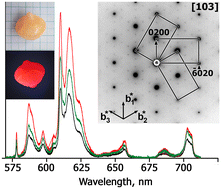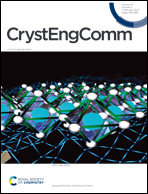K5Eu(MoO4)4 red phosphor for solid state lighting applications, prepared by different techniques†
Abstract
The influence of preparation techniques on the structure and luminescent properties of K5Eu(MoO4)4 (KEMO) was investigated. KEMO phosphors were synthesized by three different techniques: solid state and sol–gel (sg) methods as well as the Czochralski (CZ) crystal growth technique. Laboratory powder X-ray diffraction (PXRD) studies revealed that all KEMO samples had a structure analogous to that of other high temperature α-K5R(MoO4)4 palmierite-type phases (space group (SG) R![[3 with combining macron]](https://www.rsc.org/images/entities/char_0033_0304.gif) m). Contrary to laboratory PXRD data, electron diffraction revealed that the KEMO crystal grown by the CZ technique had a (3 + 1)D incommensurately modulated structure (super space group (SSG) C2/m(0β0)00) with the modulation vector q = 0.689b*. A detailed analysis of electron diffraction patterns has shown formation of three twin domains rotated along the c axis of the R-subcell at 60° with respect to each other. Synchrotron XRD patterns showed additional ultra-wide reflexes in addition to reflections of the R-subcell of the palmierite. However, the insufficient number of reflections, their low intensity and large width in the synchrotron X-ray diffraction patterns made it impossible to refine the structure as incommensurately modulated C2/m(0β0)00. An average structure was refined in the C2/m space group with random distribution of K1 and Eu1 in [M1A2O8]-layers of the palmierite-type structure. The dependence of luminescent properties on utilized synthesis techniques was studied. The emission spectra of all samples exhibit intense red emission originating from the 5D0 → 7F2 Eu3+ transition. The integrated intensity of the emission from the Eu3+ 5D0 term was found to be the highest in the crystal grown by the CZ technique. The quantum yield measured for KEMO crystals demonstrates a very high value of 66.5%. This fact confirms that KEMO crystals are exceptionally attractive for applications as a near-UV converting red phosphor for LEDs.
m). Contrary to laboratory PXRD data, electron diffraction revealed that the KEMO crystal grown by the CZ technique had a (3 + 1)D incommensurately modulated structure (super space group (SSG) C2/m(0β0)00) with the modulation vector q = 0.689b*. A detailed analysis of electron diffraction patterns has shown formation of three twin domains rotated along the c axis of the R-subcell at 60° with respect to each other. Synchrotron XRD patterns showed additional ultra-wide reflexes in addition to reflections of the R-subcell of the palmierite. However, the insufficient number of reflections, their low intensity and large width in the synchrotron X-ray diffraction patterns made it impossible to refine the structure as incommensurately modulated C2/m(0β0)00. An average structure was refined in the C2/m space group with random distribution of K1 and Eu1 in [M1A2O8]-layers of the palmierite-type structure. The dependence of luminescent properties on utilized synthesis techniques was studied. The emission spectra of all samples exhibit intense red emission originating from the 5D0 → 7F2 Eu3+ transition. The integrated intensity of the emission from the Eu3+ 5D0 term was found to be the highest in the crystal grown by the CZ technique. The quantum yield measured for KEMO crystals demonstrates a very high value of 66.5%. This fact confirms that KEMO crystals are exceptionally attractive for applications as a near-UV converting red phosphor for LEDs.



 Please wait while we load your content...
Please wait while we load your content...